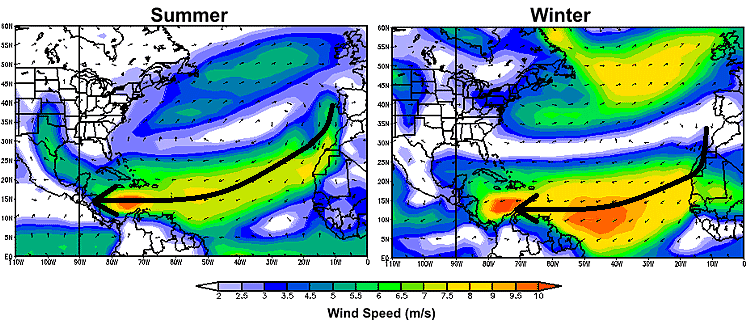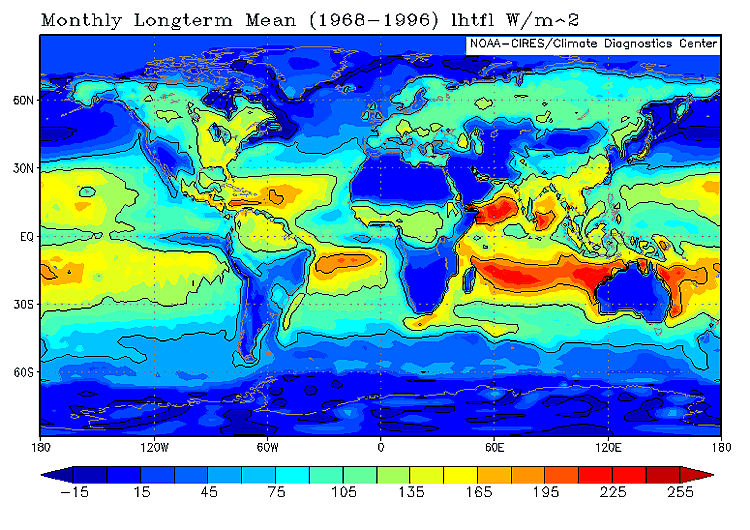Prioritize...
Upon completion of this page, you should be able to explain the formation of the trade winds, identify the typical direction from which they blow in each hemisphere, and discuss their role in moisture transport and cloud / precipitation formation.
Read...
Early in this lesson, one of the quirks of tropical weather I mentioned was the tendency for a single surface wind direction to dominate for most of the year. Furthermore, these persistent winds tend to be a bit speedier than we might expect, given the fact that pressure gradients in the tropics are small overall. Now it's time to explore these topics and "close the loop" of the Hadley circulation by talking about the bottom of the circulation -- the trade winds. The near-surface return flow toward the equator from the subtropical highs constitutes the trade winds (you may want to refresh yourself one more time with this Hadley Cell schematic).
Air parcels sinking around the cores of the subtropical highs possess little west-east motion relative to the earth's surface, having lost their residual eastward motion during the long descent from the upper branches of the Hadley Cells. As air on the eastern flanks of the subtropical highs moves equator-ward, it starts turning toward the west, forming the trade winds (as seen in the images of summer and winter wind vectors below). In the Northern Hemisphere, the trade winds blow from the northeast at modest speeds between 10 and 25 miles per hour across the belt of low latitudes, where pressure gradients are typically lax. The trade winds blow from the southeast in the Southern Hemisphere, but we're going to focus most of our analysis on the Northern Hemisphere for simplicity's sake.

How does the northeasterly motion of the trade winds develop and how do they get so "speedy" with such small pressure gradients? The answer to the first question is, of course, the Coriolis force (southward moving air gets directed toward the right, or west, in the Northern Hemisphere). The answer to the second question is a bit more complex and requires us to think really "big picture" about angular momentum for a moment. As parcels move southward toward the equator, their distance from the earth's axis of rotation increases, which would cause them to slow down (like an ice skater stretching out his or her arms in a spin). At first glance, this situation would seem to lead to rather sluggish trade winds, but the trade winds are tricky!
The trade winds are actually a bit speedier than the pressure gradient alone might suggest, and the reason why comes down to conservation of momentum. In an absolute sense (say, to an observer looking down on Earth from space), all air parcels in the atmosphere have some eastward momentum, because the atmosphere moves along with the rotation of the earth (which is toward the east). Even parcels that move westward relative to earth's surface still have eastward momentum overall because the entire atmosphere is moving eastward in an absolute sense. So, when parcels "slow down" as they move equator-ward, what I really mean is that they must lose some of their overall eastward momentum as they move farther away from earth's axis of rotation. As these parcels move southward (in the Northern Hemisphere), they lose some eastward momentum by accelerating in the opposite direction -- toward the west (relative to the earth's surface), as the Coriolis force acts on them.
I'm skipping some of the nitty-gritty details, but the bottom line is that the faster speeds of the trades (compared to what we might think given rather small pressure gradients in the tropics), are a manifestation of the earth and atmosphere trying to conserve angular momentum in an "absolute" sense. Along the way, the trades play a critical role in transporting moisture that feeds the showers and thunderstorms that rise in the ITCZ. As they flow from the subtropics toward the ITCZ, evaporation of ocean water occurs over the vast ocean expanse covered by the trades. To see what I mean, check out the image below. Technically, this image shows something called "latent heat flux," but we can use it as a proxy for evaporation rates (you may recall that "latent heating" refers to the energy exchanges that occur during phase changes).

The trade wind belts display a maximum in "latent heat flux" because of the abundant evaporation that occurs there as the trades flow briskly over open ocean waters. Evaporation increases the amount of water vapor in the lower troposphere as the trades flow toward the ITCZ, and shallow rising currents of moist air frequently yield fields of "trade-wind cumulus clouds" (credit: NASA) throughout the trade-wind belt. Ultimately, however, the additional water vapor gained from evaporation as the trades flow equator-ward helps to feed the tall cumulonimbus clouds that form the showers and thunderstorms of the ITCZ in the ascending branch of the Hadley Cell.
But, along the way, the persistent trades sometimes encounter tall mountains, setting up a scenario with persistent orographic lift (upslope flow). Armed with moisture that evaporated from the oceans, the trades help create some of the wettest places on Earth as air ascends tall mountains. For example, near the summit of Mount Waialeale on the Hawaiian island of Kauai, 350 to 400 inches of rain typically fall each year! Much of this rain falls from orographic lift as the persistent trades ascend the windward steep terrain of Mount Waialeale, making the mountain one of the wettest places in the world.
Summary of the Hadley Cell
Now that we've covered the trades, we've completed the entire Hadley circulation. To summarize:
- The ITCZ and the ascending branch develops in response to strong solar heating in the tropics
- In the upper branch, air spirals (thanks to the Coriolis force) poleward toward 30-degrees latitude from the tops of ITCZ thunderstorms, culminating in the subtropical jet stream
- Air converges in the upper troposphere near 30-degrees latitude, causing the formation of the belt of subtropical highs. Air sinks over these latitudes, and warms greatly on descent
- Near the surface, the return flow of air toward the ITCZ forms the trade winds (from the northeast in the Northern Hemisphere; from the southeast in the Southern Hemisphere), which transport moisture (via evaporation of ocean water) to help feed the cumulonimbus clouds of the ITCZ
With our coverage of the Hadley Cell complete, we're going to turn our attention to a couple of weather and climate features of the tropics that you've perhaps heard of, because they can have dramatic impacts on weather even outside the tropics! As it turns out, the trades play an important role in our first topic ("monsoons"). As the ITCZ shifts northward into the Northern Hemisphere during summer, the Southern Hemisphere's southeasterly trades cross the equator and help incite heavy rains in Southeast Asia. Although you've probably heard the term "monsoons" before, as you're about to see, there's much more to them than just rain!